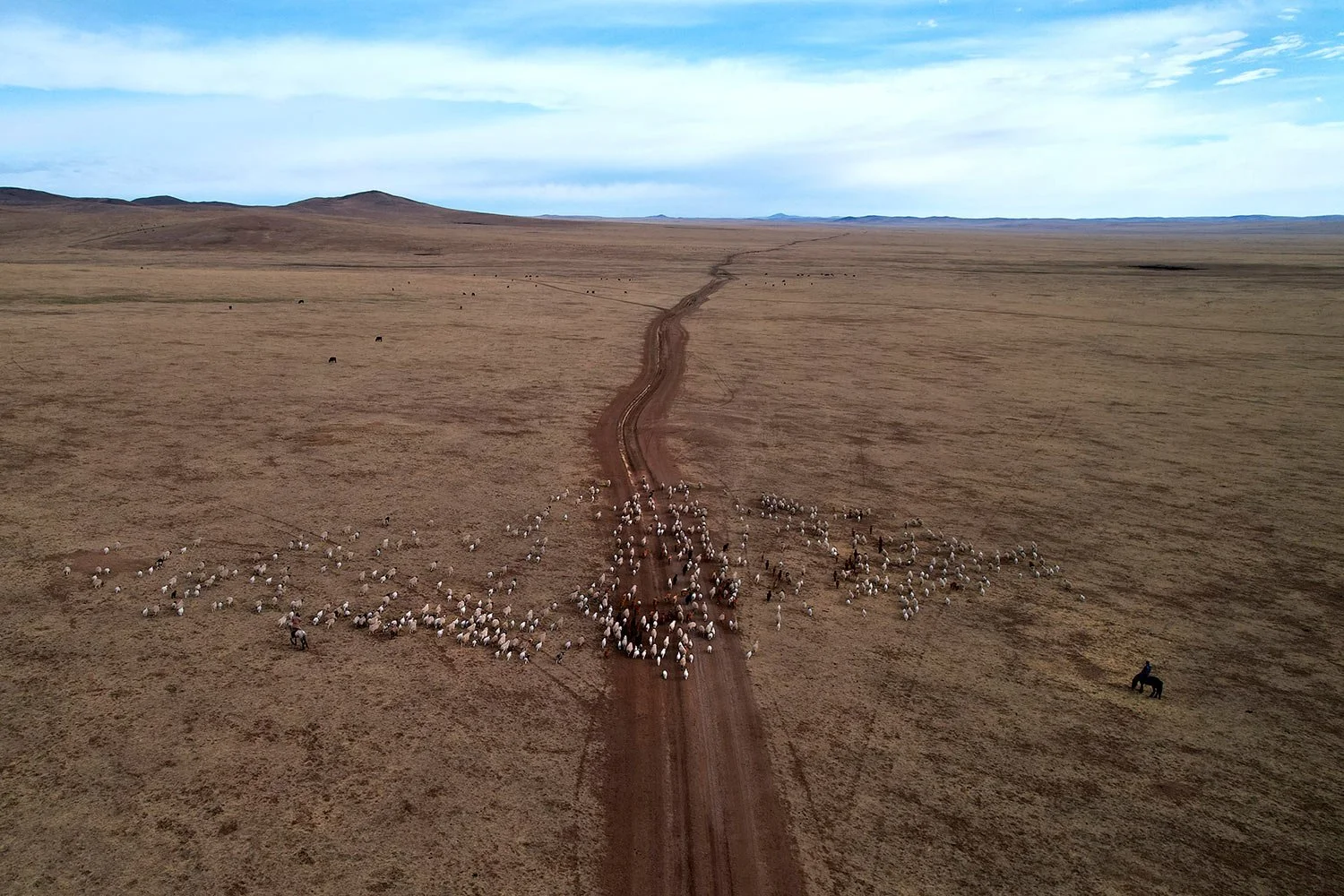Mongolia's herders fight climate change with their own adaptability and new technology

For millennia, herders in Mongolia and their animals have lived and died together in the country's vast grasslands, slowly shaping one of the last uninterrupted ecosystems of its kind.
And at first glance, everything appears the way it may have looked all those years back.
A herder watches attentively as a horse gave birth on a cold spring morning. Families look for pastures for their animals to graze. Gers — traditional insulated tents made with wooden frames — still face east and the rising sun, as they have for nomads since the days of Genghis Khan.
Herder Lkhaebum, 71, and his assistant herder take a cigarette break on their way to new location for them and livestock in the Munkh-Khaan region of the Sukhbaatar district, in southeast Mongolia, Sunday, May 14, 2023. (AP Photo/Manish Swarup)
But climate change is altering everything: Since 1940, the country’s government says, average temperatures have risen 2.2 degrees Celsius (nearly 4 degrees Fahrenheit). With the increase comes the threat of pastures being eaten away by an encroaching desert and water sources drying out. And dzuds — natural disasters unique to Mongolia caused by droughts and severe, snowy winters — have grown harsher and more frequent.
“We need more rain,” said Lkhaebum, who like other Mongolians uses only his given name and has been herding for decades.
Lkhaebum and other nomads of Mongolia have adapted, once again, adding new technologies to their arsenal of traditional knowledge to negotiate an increasingly unreliable climate. Motorbikes mean they can zip through dust storms to look for lost sheep. Solar energy means they can keep their phones charged and access the internet to exchange information with neighbors about newer pastures, and keep their freezers going to preserve meat for lean days.
Nurmaa, the wife of herder Agvaantogtokh, undertakes a 24-kilometer (15-mile) journey with the family's livestock to a new location in the Munkh-Khaan region of the Sukhbaatar district, in southeast Mongolia, Sunday, May 14, 2023. (AP Photo/Manish Swarup)
The ability to deal with climate change will also impact those who live in cities, including the capital, Ulaanbaatar. The 1.6 million people of the city constitute nearly half of the country's population, and more people are moving in every day. Construction is booming to provide housing, skyscrapers dot the skyline, and roads are snarled with large cars.
And every day, trucks arrive in urban markets with animals raised in the countryside to feed city inhabitants.
Sukhbaatar Square, where protesters had rallied in 1990 to demand freedom from a weakening Soviet Union, now has young boys playing basketball in the evening. Many don't see a future in herding, but they admit the importance that nomads and their animals have in their culture.
An assistant herder for Lkhaebum smokes a cigarette sitting outside a ger after a sudden dust storm at dusk in the Munkh-Khaan region of the Sukhbaatar district, in southeast Mongolia, Saturday, May 13, 2023. (AP Photo/Manish Swarup)
Lkhaebum, 71, wipes his face inside his ger after day's hard work in the Munkh-Khaan region of the Sukhbaatar district in southeast Mongolia, Saturday, May 13, 2023. (AP Photo/Manish Swarup)
Raw meat is boiled for supper in the ger of herder Lkhaebum. (AP Photo/Manish Swarup)
Herder Lkhaebum's family members share a supper of boiled meat in their ger, a portable, round tent insulated with sheepskin, upon their arrival at a new pasture in the Munkh-Khaan region of the Sukhbaatar district, in southeast Mongolia.. (AP Photo/Manish Swarup)
Herder Lkhaebum and his son, Agvaantogtokh, have breakfast before starting their day at a new pasture in the Munkh-Khaan region of the Sukhbaatar district in southeast Mongolia, Monday, May 16, 2023. (AP Photo/Manish Swarup)
A lone horse grazes in the Munkh-Khaan region of the Sukhbaatar district, in southeast Mongolia, Saturday, May 13, 2023. (AP Photo/Manish Swarup)
Family members of herder Lkhaebum erect their ger, a portable, round tent insulated with sheepskin, upon arrival at a new pasture in the Munkh-Khaan region of the Sukhbaatar district in southeast Mongolia, Sunday, May 15, 2023. (AP Photo/Manish Swarup)
A herder from the region of Sukhbaatar district in southeast Mongolia carries horses and goats in the back of his truck on Saturday, May 13, 2023, on his way to sell in the capital, Ulaanbaatar. (AP Photo/Manish Swarup)
Traffic crawls between high rise buildings in Ulaanbaatar, the capital of Mongolia, Monday, May 22, 2023. (AP Photo/Manish Swarup)
Customers shop for meat at a wholesale market in the Mongolian capital, Ulaanbaatar, on Monday, May 22, 2023. (AP Photo/Manish Swarup)
Women wait as their children play during a fair in Ulaanbaatar, the capital of Mongolia, Sunday, May 21, 2023. (AP Photo/Manish Swarup)
Children play basketball at a city square in Ulaanbaatar, the capital of Mongolia, Sunday, May 21, 2023. (AP Photo/Manish Swarup)
A family wearing traditional clothing visits famous Gandan Buddhist monastery on the first day of summer, in Ulaanbaatar, the capital of Mongolia, Monday, May 22, 2023. (AP Photo/Manish Swarup)
Horse-mounted Mongolian army soldiers ride in their ceremonial uniforms in Ulaanbaatar, the capital of Mongolia, Sunday, May 21, 2023. (AP Photo/Manish Swarup)
Lead photo: Lkhaebum's son, Agvaantogtokh, chooses a horse to ride as he prepares for the journey to move the family's two hundred horses to new grassland in the Munkh-Khaan region of the Sukhbaatar district, in southeast Mongolia, Saturday, May 13, 2023. (AP Photo/Manish Swarup)
___
EDITORS’ NOTE — This story is part of The Protein Problem, an AP series that examines the question: Can we feed this growing world without starving the planet? To see the full project, visit https://projects.apnews.com/features/2023/the-protein-problem/index.html
___
Text from AP News story, AP PHOTOS: Mongolia's herders fight climate change with their own adaptability and new technology, by Manish Swarup and Aniruddha Ghosal
Photos by Manish Swarup






